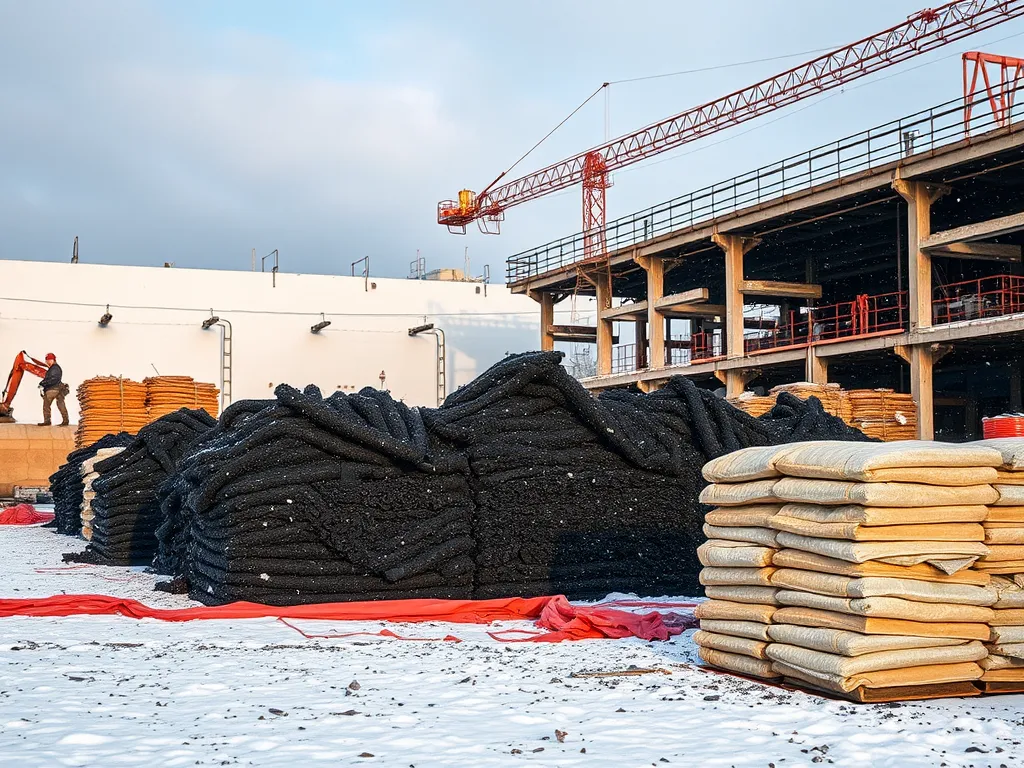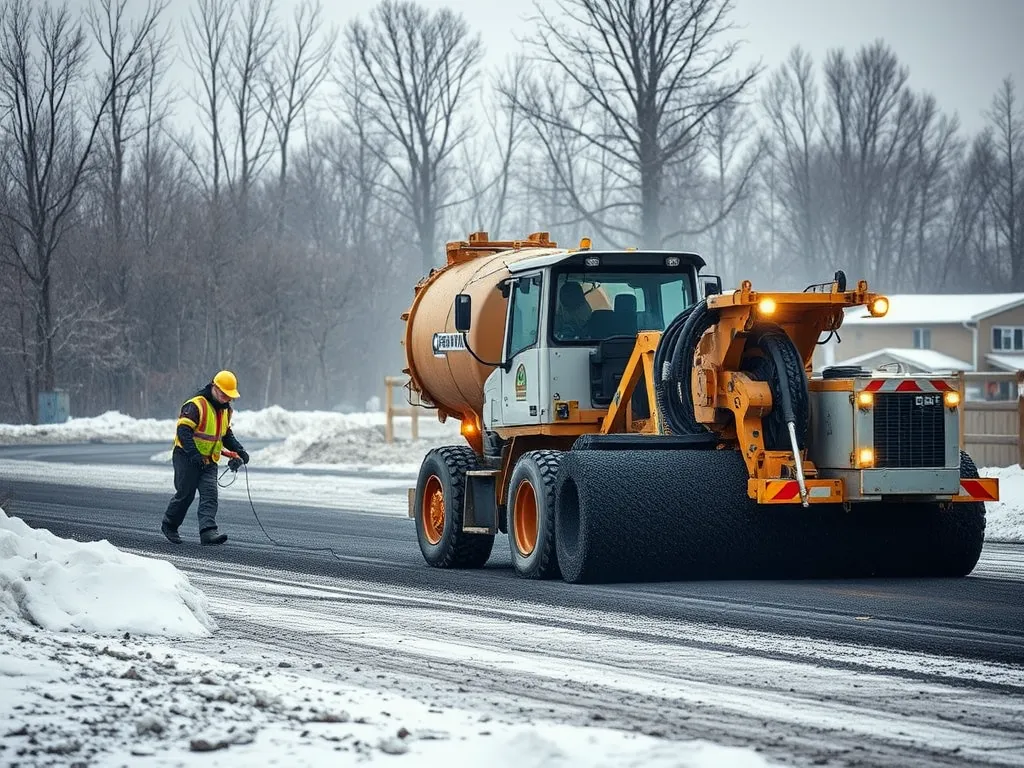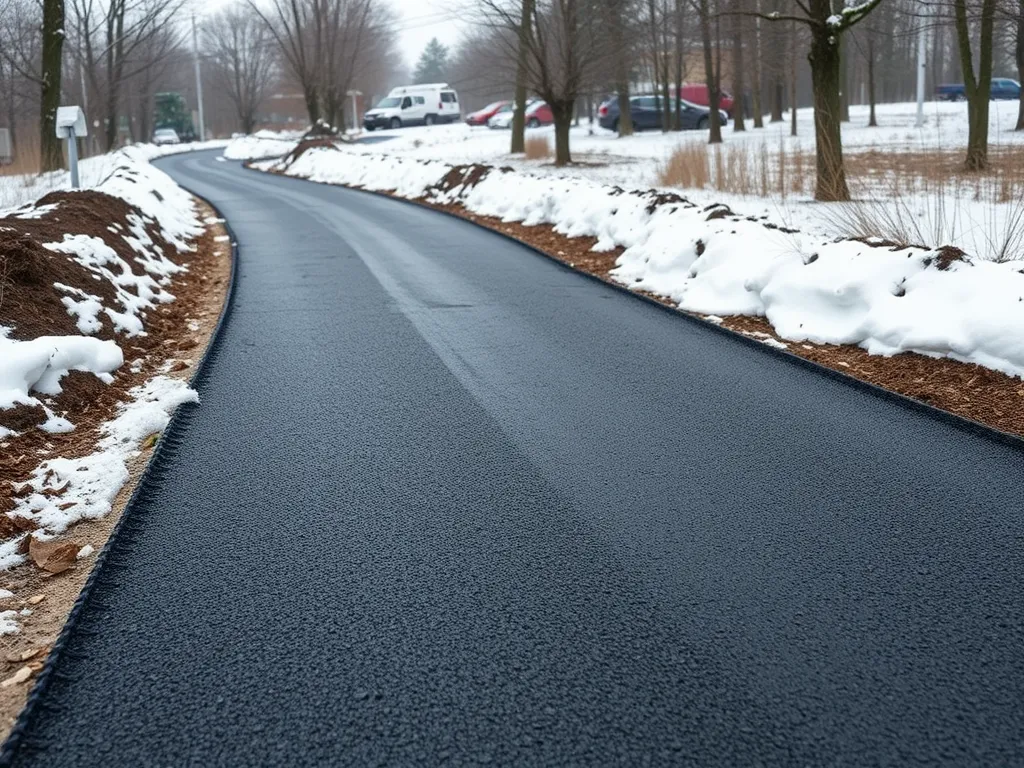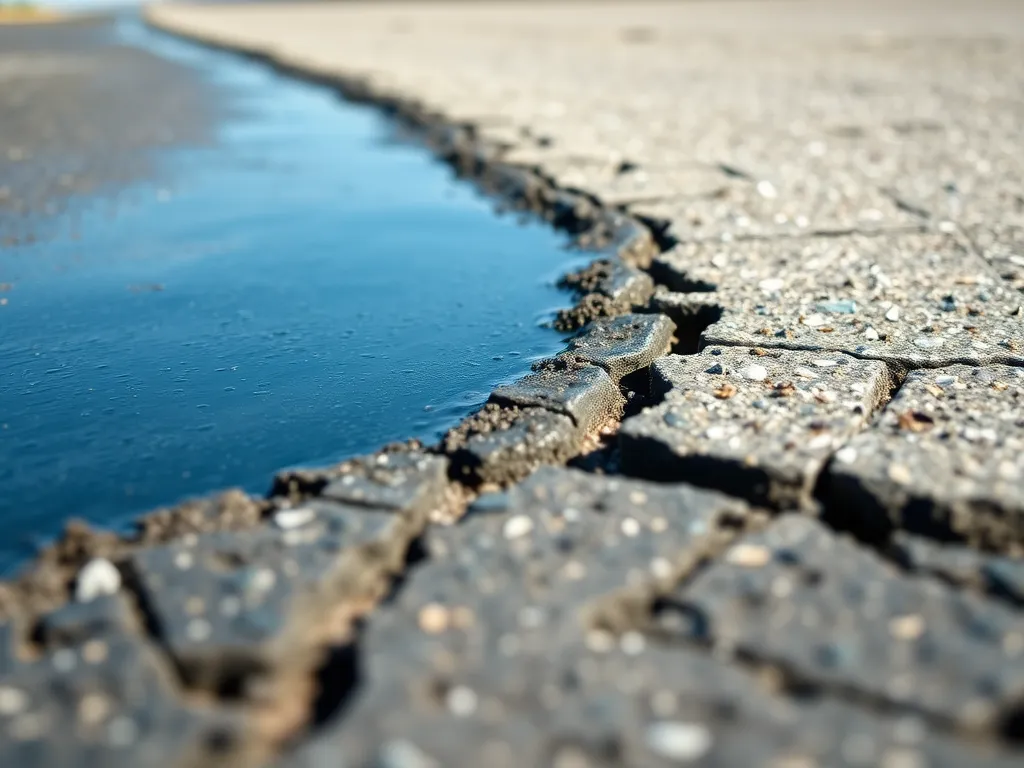Can You Install Asphalt in the Winter?
Published on: October 3, 2025 | Last Updated: April 14, 2025
Written By: George Voss
Yes, asphalt can be installed in winter with proper planning and adjustments. Hot mix asphalt requires ground temperatures above 40°F (4°C) for proper compaction and curing. Contractors use PG (Performance Grade) binders modified for cold weather and monitor moisture levels in frozen subgrades. Winter projects often cost 15-30% more due to heated materials, expedited timelines, and specialized equipment like thermal blankets. Rapid cooling risks poor density and surface defects if temperatures drop below critical thresholds during installation.
This article breaks down winter asphalt feasibility by temperature zones, material science, and regional best practices. Learn how cold mix asphalt handles emergency pothole repairs at 20°F (-6°C), why warm mix asphalt extends paving windows, and how Georgia crews tackle frost-prone projects. We’ll cover cost-saving strategies, environmental impacts of winter production, and alternatives when full installation isn’t possible.
Contents
- Feasibility Of Asphalt Installation in Winter
- Minimum Temperature Requirements for Laying Asphalt
- Challenges Of Winter Asphalt Paving
- Winter-specific Asphalt Solutions
- Best Practices for Cold Weather Asphalt Jobs
- Cost Considerations for Winter Asphalt Work
- Workforce Availability in Winter Months
- Alternatives to Full Asphalt Install
- Environmental Considerations
- Frequently Asked Questions
- Final Thoughts
- Additional Resources for You:
Feasibility Of Asphalt Installation in Winter
Winter asphalt work is possible but demands strict control of job site variables. Success hangs on managing mix temps, ground status, and air conditions. Projects north of 40°F ambient air temp typically yield good results, but cold-weather mixes allow work down to 20°F with proper planning.
Key Factors Influencing Winter Asphalt Projects
Four pillars dictate winter paving viability: binder type, base layer prep, delivery logistics, and compaction timing. Contractors must adjust mix designs and installation tactics for frost-prone conditions.
Impact of Temperature on Asphalt Binder Performance
Binders (PG grades like PG 64-22) stiffen rapidly below 50°F. Hot mix asphalt cools 2-3x faster in winter air vs summer, risking incomplete compaction. Winter-specific binders with polymer modifiers maintain flexibility at 15-20°F lower temps than standard mixes. For critical projects, infrared heaters may boost surface temps by 50°F pre-paving.
Ground Conditions and Moisture Challenges
Frozen subgrades cause two issues: ice melts under fresh asphalt, creating voids, and frost heave shifts pavement layers. Moisture content above 5% in base materials risks weak bonding. Pros combat this with ground thawing systems ($3-$5/sf cost) or delay work until soil temps stay above 32°F for 48+ hours.
With frost factors managed, focus shifts to mix temp thresholds – a topic we’ll unpack next.
Minimum Temperature Requirements for Laying Asphalt
Hot mix asphalt (HMA) has strict thermal limits for proper installation. Mixing plants typically heat HMA to 300-350°F, but ambient air and ground conditions dictate if paving can occur. Let’s break down what’s workable versus what’s risky.
Ideal Vs. Critical Thresholds for Hot Mix Asphalt
HMA performs best when laid in air temps above 50°F. Below this mark, cooling accelerates – mix loses 4-5°F per minute in freezing winds. PG (Performance Graded) binders, which classify asphalt by climate suitability, stiffen rapidly under 40°F. ASTM D3515 sets 40°F as the critical cutoff for standard HMA. Contractors pushing this limit risk poor compaction – density drops 2-3% per 10°F below 50°F, weakening pavement structure.
Cold Weather Asphalt Mix Adaptations
Specialized mixes tackle winter paving hurdles. WMA (Warm Mix Asphalt) uses wax or chemical additives to stay workable at 30-40°F, cutting fuel use by 20%. Cold mix asphalt, made with emulsified binders, handles temps down to 0°F but costs 15-20% more than HMA. Some crews blend RAP (Recycled Asphalt Pavement) at 30% rates to boost mix warmth. Thermal blankets post-installation can hold surface heat above 25°F for up to 48 hours.
While these adaptations make winter paving possible, crews still face material handling hurdles. Next, we’ll outline common cold-weather obstacles – from rapid cooling to snow delays – and how pros tackle them.

Challenges Of Winter Asphalt Paving
Cold weather introduces unique hurdles for asphalt projects. Let’s break down the three most critical obstacles crews face when paving in winter conditions.
Material Cooling and Compaction Issues
Hot mix asphalt needs to stay above 275°F during placement. Below 50°F ambient temperatures cause rapid heat loss. This leads to:
- Thermal segregation (uneven temperature distribution)
- Compaction density below 93% of maximum theoretical density
- Premature cracking and raveling
Road crews must complete rolling within 10-15 minutes at 20°F, compared to 30+ minutes in warm weather. Cold rollers struggle to achieve proper density, risking pavement failure within 2-3 years.
Extended Setup Time in Freezing Conditions
Asphalt binders thicken significantly below 40°F. PG 58-28 binder viscosity increases by 400% at 32°F compared to 70°F. This delays:
- Curing time: 48+ hours vs. 8-12 hours in summer
- Traffic readiness: 5-7 days vs. 24 hours for light vehicles
Frozen ground acts as a heat sink, pulling energy from the asphalt mat. Infrared scans show temperature drops of 2-3°F per minute on frozen subgrades versus 0.5°F on warm bases.
Snow/ice Interference With Installation
Winter precipitation creates multiple work-stoppage scenarios:
- 1/8″ ice layer reduces asphalt-base bond strength by 60%
- Snowfall during paving requires immediate mat abandonment
- Frost depths exceeding 12″ make proper compaction impossible
Contractors report 35% longer project timelines for winter asphalt work due to weather delays. Each inch of snow accumulation adds 2-3 hours of cleanup before paving can resume.
While winter creates unique obstacles, specialized techniques and materials can make cold weather asphalt paving feasible. Next, we’ll explore winter-specific asphalt solutions that tackle these challenges head-on.
Also See: Stay Safe: Community Education on Asphalt Safety
Winter-specific Asphalt Solutions
Freezing temperatures demand specialized materials and methods for successful asphalt work. Two proven options address cold weather challenges: cold mix for quick fixes and warm mix for larger projects.
Cold Mix Asphalt for Emergency Repairs
Pre-made cold mix asphalt contains emulsified binders that remain pliable down to 20°F. Stockpiled by road crews, this material requires no heating – just direct application into potholes or cracks. Unlike standard hot mix (320-350°F production temp), cold mix uses PG 58-28 or PG 64-22 binders modified for freeze-thaw resistance.
Application Techniques for Temporary Fixes
Apply cold mix at 2″ layers, compacting each pass with vibratory plate compactors. For better adhesion, spray tack coat on repair edges first. Temporary patches typically last 3-6 months until permanent hot mix repairs become viable above 40°F.
Warm Mix Asphalt for Extended Work Windows
Warm mix asphalt (WMA) allows paving crews to work at temps 50°F lower than standard hot mix. Additives like zeolites or organic waxes lower production temps to 225-275°F while maintaining workability. This extends the paving season by 4-6 weeks in northern states and reduces fuel consumption by 20-35% during production.
Proper material selection sets the stage for effective cold weather paving – next we’ll explore field-tested methods to maximize winter project success.

Best Practices for Cold Weather Asphalt Jobs
Winter asphalt projects demand precise adjustments to combat temperature challenges. Three proven strategies ensure successful cold-weather installations while maintaining pavement quality.
Pre-heating Aggregate Materials
Aggregates stored below 40°F create mix temperature drops that compromise binder effectiveness. Contractors heat stone and sand to 150-200°F before mixing with PG binders. This step prevents thermal shock, maintains workable mix temps above 275°F, and ensures proper adhesion to existing surfaces. Pre-heated materials reduce roller passes needed for 92%+ density targets.
Optimized Crew Scheduling for Daylight Hours
Pave between 10 AM and 4 PM to leverage peak ambient temperatures. Crews gain 15-20% more productivity during these thermal windows compared to early morning work. Use real-time weather apps to track cold fronts – a 5°F drop during installation can shorten compaction time by 12 minutes per 100 sq ft.
Protecting Fresh Asphalt From Frost
Ground frost beneath new pavement causes premature cracks. Apply thermal blankets ($0.35-$0.75 per sq ft) immediately after rolling to slow heat loss. Maintain surface temps above 50°F for 48 hours using windbreaks or heated enclosures in extreme cold. Check overnight forecasts – even one freeze cycle within 72 hours of installation risks surface raveling.
These cold-weather tactics require careful budget planning. Next, let’s examine how seasonal adjustments affect project costs and labor demands.
Cost Considerations for Winter Asphalt Work
Cold weather asphalt paving demands careful budget planning. Specialized materials and workforce adjustments drive expenses higher compared to warm-season projects.
Price Premiums for Temperature-controlled Mixes
Winter mixes like warm mix asphalt (WMA) cost 8-15% more than standard hot mix. Suppliers add additives to maintain workability:
- Organic waxes ($3-$5 per ton extra)
- Chemical surfactants
- PG 58-28 binders rated for -28°F performance
Plants may charge $10-$20/ton heating surcharges when outdoor temps drop below 40°F. Cold mix asphalt – used for emergency repairs – runs $120-$150/ton versus $90-$110/ton for standard hot mix.
Labor Efficiency Challenges
Shorter daylight hours (December averages: 9.5 hrs in Atlanta vs 14.5 hrs in June) cut production by 25-40%. Crews face:
- Frost delays requiring propane heaters ($200/day rental)
- 15-30% slower compaction times
- Overtime pay for weather window rush jobs
One Michigan contractor reported 38% higher labor costs for January driveway installations versus spring projects.
These financial factors intersect with workforce availability – a key factor for winter asphalt success.
Managing budgets becomes even more complex when accounting for crew accessibility during freezing months.

Workforce Availability in Winter Months
Winter asphalt projects face staffing challenges as many contractors scale back operations. Seasonal demand drops 40-60% in snowbelt states, creating crew shortages when weather breaks allow work. Projects require teams ready to mobilize quickly between storms.
Scheduling Asphalt Crews Around Weather Windows
Paving companies track weather models to align staff with 12-36 hour work windows. Thermal blankets and infrared heaters let crews place hot mix asphalt (HMA) at 35°F air temps when timed with solar gain. Northern operators keep winter teams on standby, paying 15-20% wage premiums for on-call availability.
| Region | Avg. Winter Crews Active | Common Mix Types |
|---|---|---|
| Minnesota | 25% of summer capacity | PG 58-28 HMA, Cold mix |
| Georgia | 80% of summer capacity | PG 64-22 HMA, Warm mix |
Regional Variations in Winter Paving Capacity
Southern states maintain near-full operations with warm mix asphalt (WMA) rated for 20°F placement. Midwest contractors switch to cold mix asphalt (CMA) for pothole repairs below freezing. Coastal regions face rain delays more than cold – 85% of Pacific Northwest winter projects use polymer-modified mixes for wet conditions.
Next: Explore temporary repair strategies when full asphalt installation isn’t feasible.
Alternatives to Full Asphalt Install
When cold stops full asphalt jobs, smart fixes keep roads safe. Use short-term repairs now. Plan full work for warmer months.
Strategic Use Of Asphalt Patch Kits
Cold mix asphalt patch kits work below 40°F. These ready-to-use blends have polymers to bind in wet, icy spots. Store kits in heated space before use. Press mix into holes with tamper tools. Patches last 6-24 months based on traffic.
| Patch Type | Temp Range | Cost per Sq Ft |
|---|---|---|
| Cold Mix | -20°F to 100°F | $0.85-$1.50 |
| Polymer-Mod | -40°F to 120°F | $1.20-$2.10 |
Preventative Crack Seal Steps
Seal cracks before first freeze to stop water damage. Clean gaps with air jets. Fill with rubberized sealant that stays flex in cold. Works best when ground temps stay above 35°F. Apply in dry fall weather for winter prep.
Sealant types: – Hot pour (needs 275°F melt temp) – Cold pour (ready-use, sets in 2 hours)
These winter-ready methods buy time. But they need proper ground prep. Now let’s see how cold mixes affect the earth.

Environmental Considerations
Winter asphalt work impacts both job sites and ecosystems. Cold temps force plants and crews to adapt – raising energy use and emission risks.
Energy Demands for Winter Production
Hot mix asphalt needs 50°F+ base temps to bond. In winter, plants burn 15-20% more fuel to hit 300°F mix temps. PG binders (asphalt’s glue) require extra heat to stay pliable. Some states use recycled engine oil to cut energy needs by 12%.
Emission Controls in Cold Conditions
Plants face EPA limits on CO, SO2, and PM2.5. Cold air slows smoke rise, increasing ground-level fumes. Modern plants use baghouses (giant filters) trapping 99% of particles. Winter mixes with warm additives lower stack temps 25°F, reducing scrubber efficiency by 8%.
These factors shape winter paving choices. Up next: how cold affects project budgets and crew plans.
Frequently Asked Questions
Can You Install Asphalt Driveways Below Freezing?
While installation below freezing is possible, it’s not ideal. Hot mix asphalt generally requires minimum temperatures above 40°F for optimal curing. However, using cold mix asphalt can facilitate repairs in temperatures as low as 20°F.
How Do Georgia’s Winters Affect Asphalt Work?
Georgia’s milder winter temperatures allow for more flexible asphalt work schedules compared to northern states. In general, Georgia paving operations can effectively function at temperatures down to 20°F with warm mix asphalt designed for such conditions.
Will Asphalt Cure Properly in Cold Weather?
Asphalt can cure in cold weather, but the process takes longer. The curing time can extend significantly, and special mixes or techniques may be necessary to ensure a successful installation and prevent premature damage.
What Temperature Makes Asphalt Unworkable?
Asphalt generally becomes unworkable below 40°F, which is considered the critical threshold for standard hot mix asphalt. At this temperature, the mix cools quickly, and compaction becomes difficult, risking the integrity of the pavement.
Final Thoughts
Asphalt installation during winter is challenging but feasible. Understanding temperature impacts, ground conditions, and material choices is key to successful projects. Utilizing warm and cold mix asphalt variations helps overcome winter hurdles while maintaining quality.
Employ best practices like pre-heating aggregates and coordinating work schedules to maximize efficiency. Weighing cost considerations and environmental factors is vital for making informed decisions. Ultimately, assess conditions carefully to determine whether to proceed with your winter asphalt project.
For more information on asphalt installation, resources, and tools, check out Asphalt Calculator USA.
Additional Resources for You:
- The Asphalt Institute. (2007). MS-4: The Asphalt Handbook. Lexington, KY: Asphalt Institute.
- Can You Do Asphalt In The Winter? – High Quality Asphalt & Concrete
- r/civilengineering on Reddit: What temperatures can asphalt be pave at night? Is there any ASTM for this application?
- Can You Lay Asphalt During the Fall or Winter? – Walt’s Paving
- Can You Start Asphalt Paving in Winter? | A-1 Asphalt Inc.


